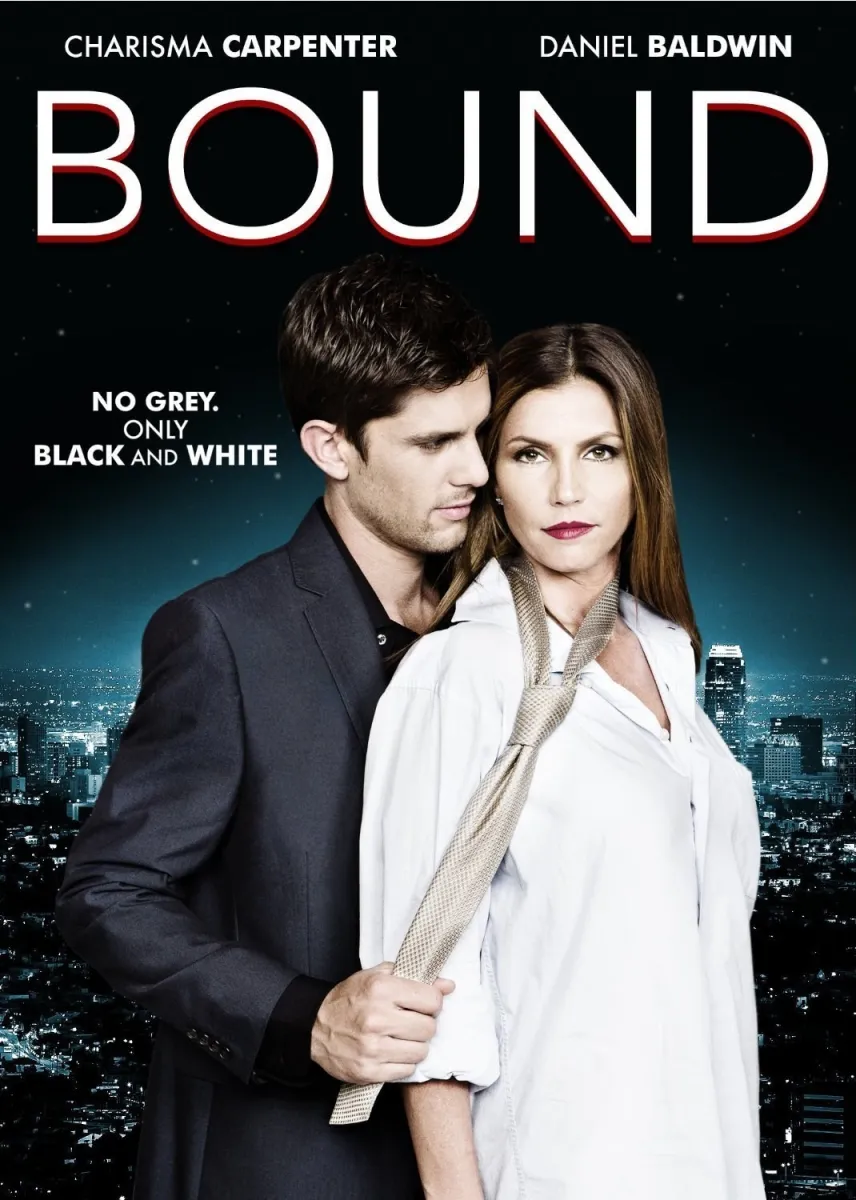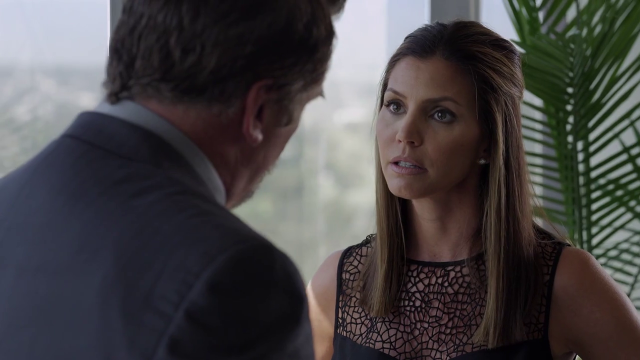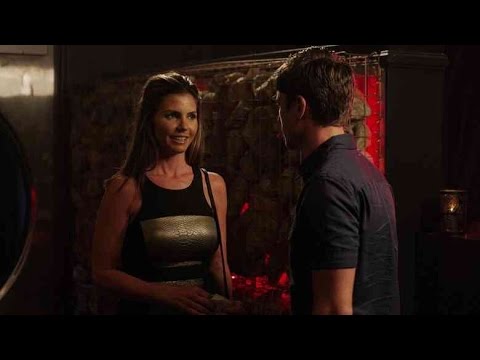Occasionally, when talking about Fifty Shades of Grey or its parent Twilight, I feel like Al Pacino in The Godfather III: Just when I think I’m out, they pull me back in. Despite their relevance having faded, they remain fascinating things to examine, discuss, and yes, ridicule. Both of them hit pop culture like a sledgehammer, and the aftershocks are still being felt. This is despite the fact that they are widely regarded as terrible, sexist, and terribly sexist.
But we’re not here to discuss the pop culture effects of Twilight, nor are we really here to discuss the effects of Fifty Shades. No, we’re here to discuss a film I discovered that puts the extremely regressive subtext (and, on occasion, text) of Fifty Shades in context—a weird little film called Bound.
No, not the well-recieved Watchowski film from 1996. No, this movie is from 2015, and it’s a strange one. Bound is, at its core, a mockbuster of Fifty Shades of Grey. For those of you who don’t know (lucky you), a mockbuster is a film designed to purposefully resemble a big budget blockbuster, but be much cheaper and released first, with the intention to confuse people into purchasing or renting the mockbuster. The studio that produced Bound, The Asylum, has gotten some mainstream recognition for its Sharknado movies and is infamous for its mockbusters.
So, Bound was designed to be released at roughly the same time as the Fifty Shades movies and was, in fact, released exactly a month earlier (January 9th, to Fifty Shades‘ February 9th). However, while the vast majority of The Asylum’s output is terrible schlock fit only to trick some inattentive Redbox customers, Bound is … slightly different. I mean, it’s still terrible schlock, but there’s something interesting bubbling beneath the surface.
First, a quick refresher course on Fifty Shades, just to make sure we’re all working from the same starting point. Don’t worry, this won’t take long. I’m not silly enough to do two in-depth plot recaps in the same article; I just need us all on the same page. Fifty Shades concerns a woman named Ana Steele who is going to college in Washington (state, not city) and runs into a man name Christian Grey, hence the title. After getting to know him, she finds out he’s really into BDSM, and he won’t date her until she agrees to be his submissive.
So what’s wrong with that, you might reasonably ask? Well the problem is how he goes about it. As depicted in both book and movie, Christian Grey’s treatment of Ana is less “romantic dominant” and more straight up abusive. He stalks her, restricts her access to friends and family, dictates where and when she sleeps, what she eats, how she dresses and wears her hair … it’s all pretty messed up. The book takes it several steps father—including him straight up raping Ana at one point—and like Twilight (Fifty Shades began as Twilight fanfiction, hence all the comparisons), all of this terrible, abusive behavior is presented like it’s romantic.
Before we move on, I want to briefly discuss a subject that comes up a lot in media criticism: intent. If a piece of media is criticized for a problematic element, often times the first response—from fans, at least—is to defend the author’s intent. That, I feel, is missing the point. Authorial intent is interesting, but it doesn’t really help us with the actual work, and it’s entirely possible for someone to create a piece of media that is … well, problematic by not paying attention to the implications of the story they were telling. Which is a long-form way of me saying that I don’t think Fifty Shades of Grey author E.L. James actually thinks these things, but that what she thinks isn’t important—what the story says is.
Since the Fifty Shades of Grey series has sold over 125 million copies, and the first movie made over 500 million dollars at the box office (5 times what Birdman made … humanity, I am disappoint) while being violently sexist, it inspired a lot of analysis. People have written about how it’s sexist, about how it’s not sexist, about how it doesn’t represent BDSM, about how Christian treats Ana like he’s a cult leader … it’s inspired a lot of think pieces is what I’m saying.
This … this is not a think piece about Fifty Shades. This is a think piece about Bound, so let’s finally get to that.
Bound, at least at the outset, seems to follow the plot Fifty Shades would have if it were based on generic romantic films rather than Twilight fanfiction. The film opens with Michelle Mulan—played by Charisma Carpenter, in case you were wondering how her career was going since Buffy—who is (sing along if you know the words) an overworked business woman who has no time for real relationships. Specifically, she’s a real estate broker, which I only know because the movie spends a TON of time on it. Seriously, if The Big Short hadn’t come out, Bound might have been the most real estate-fixated film of 2015.
But I digress. In between unfulfilling dates, Michelle is trying to keep her father’s business afloat and isn’t being taken seriously, because she’s not particularly assertive, and her father doesn’t take her seriously, either. Also, it could be because her father is played by Daniel Baldwin, who is only 10 years older than her, but what do I know? She’s also failing to maintain her relationship with her daughter, who I normally would skip over, but she’ll become important later.
While out to dinner, she runs into a man named Ryan Black (Bryce Draper, and that name is not as funny as they think), who is 15 years younger than her, hits on her, and eventually seduces her. It turns out he’s into some really kinky stuff, up to and including BDSM, which is fine, but he starts getting more controlling, demanding that she continue sexually serving him at work functions and refusing when she asks that they switch.
This all seems pretty similar to Fifty Shades‘ storyline, but here’s where it gets interesting. At this point, she begins pushing back more seriously, asking if she ever gets to be the dom or if he’s interested in a real relationship, and he gets angry and storms out. She then goes out to the BDSM club he took her to once (oh yeah, he takes her to a BDSM club at one point) and one of the other Doms goes on a really long lecture about how Ryan doesn’t represent proper Domming and how he’s a dangerous criminal.
Now that’s already kind of interesting, using the bare bones of Fifty Shades‘ story to explicitly verbalize some of the most pervasive criticism of it, i.e. that it doesn’t represent BDSM culture well. I can’t really speak to that, as it’s pretty far outside my area of expertise, but that’s not really what I’m here to talk about. No, what I’m here to talk about is what happens next.
So Ryan, being a mature and stable sort, decides to go behind Michelle’s back and seduce her daughter, who is both 16 and her daughter, so that’s gross in two different ways. So, she stops seeing him, and he … doesn’t take that well. Specifically, he stalks her, harasses her, and quickly escalates to straight up assaulting her. So she fights him off, ties him up, and … doms him against his will, which looks disconcertingly similar to torture. She then has him arrested for having sex with her daughter, who is underage.
After that, she returns to her father’s business and is suddenly taken seriously. She is far more assertive, and manages to negotiate her way into a merger rather than having her father’s business taken over, during which time they again spend like half an hour banging on about real estate. She also seduces a rival business partner with some of her *ahem* newfound skills.
OK, so there’s a lot to unpack about the way that third act unfolds—not all of it good—but there are a couple of interesting ideas buried in there. The first is the subject of reclaiming sexuality. Now, the debate about sex positive feminism and reclaiming sexuality is already a thorny one, and one I do not have time to go into at all, but it’s undeniable that the film is in favor of it. Michelle is definitively more happy and free in the third act of the film, when she embraces her desires and finds herself in control of her sexuality.
More than that, it turns Bound into an explicit condemnation of Fifty Shades‘ story. I’ve not read them in detail (because the Fifty Shades series totals over 1600 pages, which for those of you counting at home, is double Gravity’s Rainbow‘s page count), but from all I’ve read, in Fifty Shades, the subtextual, and often textual, theme is that Ana must submit to Grey’s will, and that she will be a happier person when she just does whatever he says, despite the fact that he is, by any objective measure, a controlling, manipulative, and overall toxic presence in her life.
Bound, on the other hand, explicitly acknowledges the fact that Ryan is a toxic presence in Michelle’s life and shows that she can only be happy once she has purged him from her life. What’s more, while her treatment of him is a little too awful for me to swallow it as heroic, it never feels like it needs to give Ryan an excuse for his behavior, or make Michelle apologize for wanting him out of her life. That is, at its core, a positive message. Toxic people are toxic, no matter what their reasons are, and you don’t owe anyone an apology or explanation for wanting them gone.
The most frustrating thing about this is that I can’t be sure how much of this is intentional. Asylum movies are designed to be made as quickly and cheaply as possible and intended to walk as close to the line of copyright infringement as possible (and only occasionally falling over it). I can’t be sure whether they intended to make a movie that condemned Fifty Shades for its retrograde subtext or if they were just writing it in a hurry, and that’s how the movie wound up.
Which might wind up being the most important takeaway, from both Fifty Shades and Bound. I don’t know what the authors of each intended, but in the end, it doesn’t matter. E.L. James might not have intended her books to come across as incredibly sexist, but that’s how it shook out on paper. That’s why it’s so important to think through the implications inherent in your story while writing it.
Regardless, Bound is available on Netflix at the time of this writing, and I can’t really recommend you see it. It’s conceptually fascinating, but not actually all that interesting to watch. It has a few moments where it falls over into being amusingly bad, and it’s probably the only instance where a Mockbuster is better than the film it’s based on (remember, that’s not saying a lot in this case), but it’s just overall not worth your time and effort, unless you’re a completionist or you really have a big crush on Charisma Carpenter.
James is a Connecticut-based, Alaskan-born cinephile with an obsession with The Room and a god complex. His interests include Warhammer 40k, the films ofNicolas Cage (both good and bad), and obscure moments in history. He writes movie reviews for Moar Powah under the name Elessar and also has a blog, where is reviewing every episode of The X-Files at I Want to Review. His twitter can be found at Elessar42, and his tumblr can be found at FootballInTuxedos.
—Please make note of The Mary Sue’s general comment policy.—
Do you follow The Mary Sue on Twitter, Facebook, Tumblr, Pinterest, & Google +?











